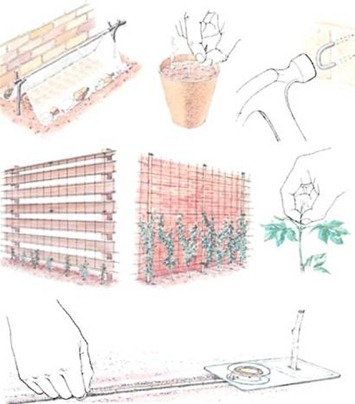





Two major objectives to be accomplished this fortnight. First, it’s time to cover-up unsightly walls, fences, sheds, concrete garages and central-heating oil-tanks. Such things can mar even the greenest of gardens. We’ll show you how to plant some highspeed ornamental vines using a modern innovation – a presown tape dispenser. Second, it’s time to get your tomato transplants into the ground. Every day you delay lessens your chance of a good crop.
Needs list: 1 pkt ornamental hop seed; 1 pkt convolvulus seed; 1 presown tape dispenser: 12×3 in diameter peat pots; 1 length 18 x 6 ft 5 in. bean netting chicken wire/trellis; 5 rustic poles 7-8ft long; 1 ball garden twine; 1 pkt wire staples; 4-6 tomato transplants + tomato growing mix + liquid feed + tomato bag; one 2 pint garden sprayer.
Time budget: 4 hours in 2 weeks
May heralds true summer at last. Whatever the vagaries of earlier spring, weather and soil both warm up now and plant growth accelerates noticeably. So, too, does the rate of increase of garden bugs. Traditionally a dry month, this can be a problem, especially if rainfall was low earlier.
If you’ve never grown a tomato before, start now. It’s by far the most popular home gardener vegetable of all. Something like 8 times as many people grow tomatoes as any other vegetable. If you’re going to grow them at all, set out to grow them better than anyone else in your street. They’re not the easiest; success starts with starting the seed early. Plant out as soon as you dare, but don’t risk frosting young plants. Then just keep watering and feeding (liquid feed) and praying for sun. There are bush and pole varieties – some of the bush ones are small enough for pots on the kitchen windowsill. Choose disease resistant varieties, and check catalogues for best varieties for your area.
1. Keep up the good work of collecting stones, stacking or storing them, and keep on adding vegetable waste to the compost bin.
2. Start mowing the lawn as soon as it starts into growth. Set the blades high for the first trim of the season. Just give it a light trim over the top. Lower the blades for a finer trim later in the season.
3. Examine vegetation (especially the beans) for aphids.
There are two types: 1 blackfly; if plants are infected, pour two tea-spoonfuls of liquid detergent into two pints of cold water in the bottle-part of a pressure insect spray. Hold the spray close to the blackfly and spray lightly. Spray again one week later. The other aphid type is greenfly – which looks just like the blackfly but is green. Problem is a green bug on a green stem is not always easy to spot – so examine vegetation very closely for this bug. Treat it the same way you treat blackfly. In both cases the bugs are killed because the solution clogs their breathing pores.
First for the vines = Flower of the Fortnight, Stage 6. Prepare the bed as in Stage 1, digging out deep-rooting, pernicious, persistent weeds. Mix in moss peat as suggested in Stage 2. Top dress with bonemeal. Using peat pots again, filled with soilless growing mix, sow 3 seeds per pot. Plunge the pots in the ground under a warm wall to get the seeds off to a good start. Put a slanting pane of glass over the pots if late frosts or heavy rains threaten. Alternatively make a clear plastic sheeting tent.

When seedlings are 2 in. high, thin out the weakest two. 2 days later move peat pots to final positions, 4 in. in front offence or trellis, spaced 12 in. apart. Use staples to fix mesh or trellis to mortar or to support poles in open ground at 4 ft. intervals. Tie in beans with twine or raffia. Alternatively sow seed in position using a presown tape and thin to 12 in. apart. Now for your tomatoes. Don’t waste time starting from seed. Save that till you’ve more experience. Buy transplants from your garden centre.
Choose plants with stems the thickness of a pencil. Avoid drawn, leggy seedlings or plants showing yellowing of the leaf. In the US and in virgin soil grow tomatoes in the ground. Take out a hole 12 in. deep, 18 in. across, refill with a mix of 50/50 nitrogen-rich compost and soil. After 2 weeks stake. Tie in plants as they grow. When they reach the top of the stake (about 4 ft.) pinch out the top. In the UK grow in tomato bags (ask your garden centre) or use ring culture. With tomato bags make an X-shaped slit and push your transplant through that into the growing mix inside the bag. For ring culture buy whalchide rings, stand them on a bed of ashes, fill with a tomato growing mix. Culture as for open ground plants. Always put tomatoes in the warmest place in your garden.
Two Hour Gardening Project: Stage 26 Climbing Plants and Pergolas
Two Hour Gardening Project: Stage 25 Getting To Know Your Garden
Two Hour Gardening Project: Stage 24 Propagation and Growing Herbs
Two Hour Gardening Project: Stage 21 Making Christmas Present Plants
Two Hour Gardening Project: Stage 20 Tubs and Container Gardening
Two Hour Gardening Project: Stage 18 Choosing Shrubs for the Garden
Two Hour Gardening Project: Stage 17 Fan Trained Fruit Trees
Copyright © www.100flowers.win Botanic Garden All Rights Reserved